3rd Scientific Bird Count accomplished at
Phansad Wildlife Sanctuary organized by
Maharashtra Forest Department and Green Works Trust.
Date: 7th, 8th and 9th January 2022

3rd Scientific Bird Count accomplished at
Phansad Wildlife Sanctuary organized by
Maharashtra Forest Department and Green Works Trust.
Date: 7th, 8th and 9th January 2022


Introduction
Phansad Wildlife Sanctuary (PWS) is a well-maintained habitat and indeed an exceptionally good place for wildlife enthusiasts to see a large variety of biodiversity at one place. It is also the only Wildlife Sanctuary in Maharashtra which shares its border with seashore, thus comprising not only waders and wetland birds but also the intertidal fauna in its list. Before the first bird count, it was considered that PWS is home to 164 birds. From 29th to 31st January 2021, Maharashtra Forest Department (MFD) and Green Works Trust (GWT) organized the first-ever scientific Bird Count in PWS using the Citizen Science initiative. The event was a success and we recorded 190 bird species with many new additions to the sanctuary. In the second bird count held on 29th, 30th and 31st October 2021, 169 bird species were counted with 4 new bird records for PWS.
In January, many migrating birds start travelling from different parts of the world. Many migrating species reside throughout Maharashtra in winters. Phansad becomes feeding ground for many of them. PWS is an amazing place with diverse habitats. Hence, overall study of Biodiversity is necessary. Through this project, GWT is involving common people in scientific study (citizen science project) under the guidance of experts. Through this activity, spreading awareness and doing conservation will be easier.
Along with birds, in first Phansad bird count (PBC) January 2021, reptiles, mammals, amphibians, and insect diversity were also observed and the data was submitted to the Forest Department. Similar methodology is followed in this bird count as well.
We are also observing the intertidal marine biodiversity of Tarabandar shore as well. This data shall help in conservation of the coastal habitat.
Due to pandemic, instead of taking 44 participants like previous bird counts, this time only 28 participants were selected. A negative RtPCR report (not older than 48 hours) was compulsory for participants and GWT officials. All the CAB (Covid Appropriate Behaviour) protocols were obeyed as per direction of WHO and Maharashtra Government to make the event safe for everyone.
Aim of PBC:
Long term monitoring of bird species & population of birds in Phansad Wildlife Sanctuary through ‘Citizen Science’ initiative.
Objectives of PBC:
This event was originally scheduled in March 2020. For this event, GWT had invited common citizens to participate in a scientific study under the guidance of experts. The announcements were made and we got responses from various States of India- Chhattisgarh, Gujarat, Madhya Pradesh, West Bengal and Maharashtra. But, due to the pandemic situation and the following lockdown, this event had to be postponed. After the ‘Unlock India’ was announced, Green Works Trust and Maharashtra Forest Department decided to conduct this long-awaited event on 19th and 20th December 2020. However, the entry of participants was restricted only to Maharashtra residents.
The Survey Area
Similar routes are repeated in every count to maintain uniformity of data. Routes were carefully identified to cover the various habitat types of PWS which are primary
evergreen forest, semi evergreen forest, moist deciduous forest, open forest, grassland, coast, Memecylon evergreen forest and inland wetland. PWS is surrounded by mangroves, cultivations, plantations, orchards, paddy fields and human habitations. Some routes already had names and a few routes were named by the team as per convenience for the event. Route selection is restricted to accessible areas in and around the sanctuary. Total 26 trails were identified.
The Methodology
The 3-day survey was conducted using 2 scientific methods of collecting data— Line Transect method and Point Count method. 19 Transect and 1 point count location were identified on trails which are shown on map.
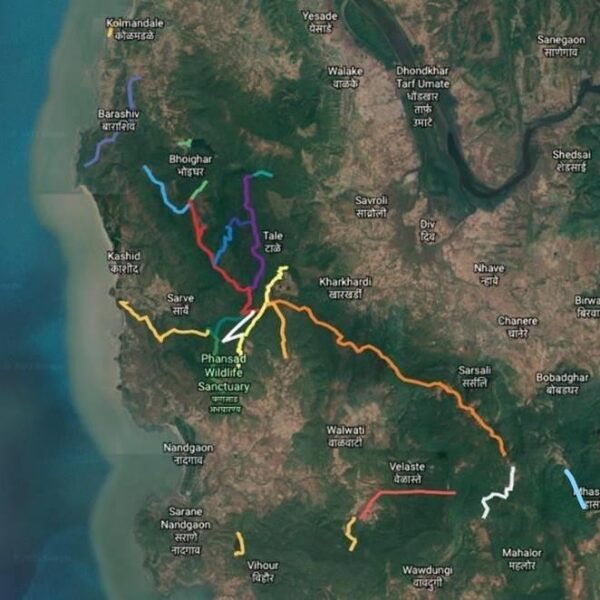
Here are the routes on which 19 Line transects were marked:
| Tembhurde to Baapdev | Supegaon to Mama Bhacha |
| Sarve to Dharnachi Gaan | Mama Bhacha to Karanji |
| Chikhal Gaan parking | Titvi to Karanjiwadi |
| Chikhal Gaan Transect | Velaste to Revechi Gaan |
| Ghunyacha Maal to Phansad Gaan | Velaste to Hele Gaan |
| Bandh Talao Phata to Saavrat Lake | Vihur Dam Transect |
| S-turn top to Ghunyacha Maal | Titvi to Mahalore |
| Kesoli Phata to Bunglow | Mhasadi Transect |
| Tar Road East to West | Vulture Restaurant to Barshiv Road |
| Supegaon to Vadghar |
|
Point Count was taken at one location i.e. Saavrat lake. Ketkichi Gaan and Tarabandar are 2 non-transect trails falling inside the sanctuary. 4 trails lying on the outside of the PWS were also selected to observe the biodiversity of the surrounding area.
| Devrai and Fields | Mazgaon Road |
| Vihur Dam Periphery | Phansad Dam |
28 participants were selected for the event and teams were formed. Teams were led by a GWT representatives and MFD Officials.
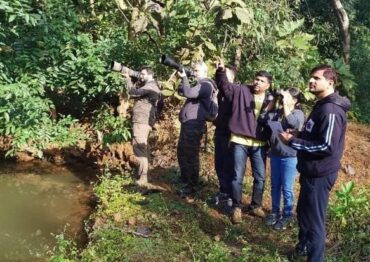

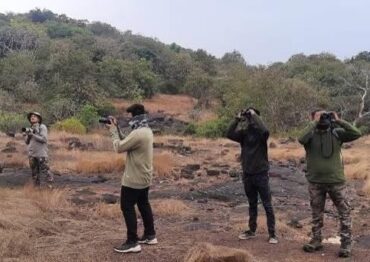

Participants observing biodiversity of different habitats of PWS during the PBC event
The Bird Count:
itizens from various walks of life — doctors, students, lecturers, businessmen, artists gathered at the Phansad Wildlife Sanctuary for this Bird Count event. The ‘Phansad Bird Count’ event was inaugurated by Assistant Conservator of Forest (ACF) Mr Nandkishor Kupte and Range Forest Officer (RFO) of PWS Mr Rajwardhan Bhosale. The event compeering was done by Mr Gaurav Patil (GWT volunteer).

Mr Gaurav Patil compering the Event
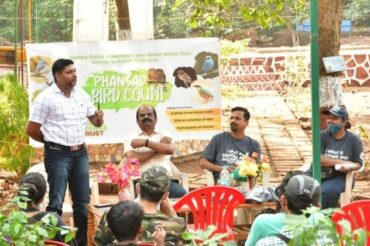
RFO Mr Rajwardhan Bhosale giving inauguration speech

ACF Mr Nandkishor Kupte giving Inauguration speech
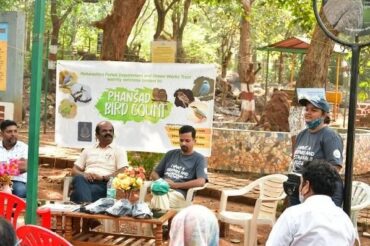
Ms Krupa Thakur-Patil introducing works of GWT and GWT team
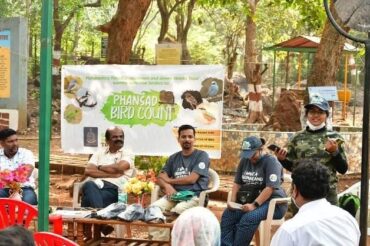
Ms Sayee Girdhari explaining the relationship between birds and plants
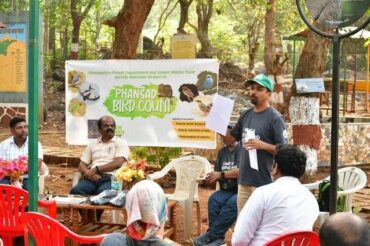
Mr Nikhil Bhopale explaining scientific methods of bird count
After inauguration session by respected officers, Ms Krupa Thakur-Patil (Founder Member and Trustee, Green Works Trust) briefly summarized the work and impact of Green Works Trust. She also introduced Green Works Trust team of PBC January 2022.
Ms Sayee Girdhari was invited as Botany expert speaker for PBC, January 2022. She took a session on relation between birds and plants and how study of plants will help in understanding of bird behaviour. The session was very impactful. Participants observed trees on which they saw birds and tried to understand the relationship between them. Seasonal appearance of flowers and fruits on different tree species, how bird visits on these trees may vary throughout the year and other such topics were discussed during the bird count
This was followed by an in-depth session by Mr Nikhil Bhopale (Founder and Managing Trustee, Green Works Trust) to all participants regarding conducting the Bird Count using scientific methodologies. Participants were briefed about how to observe birds and fill the datasheet with necessary information.
A special area was created for the participants to practice the visual judgement of 20-meter distance used during transect and point count methods. This proved to be a helpful exercise for the participants before going on the field. Participants learnt how researchers collect data and were happy that they were part of such activity.
GWT ensured that participants get to visit different habitats during the event. On the afternoon of 7th January, all the teams left campus for their 1st late afternoon trails. The first trail was for observation and checklist of every possibly observable biodiversity. Trails & teams were shuffled for every visit. In morning trails of 8th and 9th January, participants collected the bird data using scientific methods of Line Transect and Point Count on datasheets specially designed for the event by GWT. Participants observed species, their population, gender, habitat, weather, activity, and strata and tried to document it on the field. Each team submitted their checklist and datasheet, after which all entries were meticulously ratified by expert Mr Nikhil Bhopale and Mr Sagar Satpute to ensure accuracy and authenticity of the collected data. Both the late afternoon trails were done to document other possible biodiversity along with birds.
In the 3-day PBC event, participants, GWT volunteers and MFD officials hiked on selected trails of the sanctuary observing the biodiversity. Admirable efforts were taken by everybody. The collected data will give a good understanding of the biodiversity of the sanctuary. Highlights of the sightings are as follows.
Total 166 species of birds were documented during the count. Birds like Sri Lanka Frogmouth, Nilgiri Wood-Pigeon, Blue-throated Flycatcher, Ultramarine Flycatcher, and Malabar Pied-Hornbill were highlights of the event. Kentish Plover was recorded on Kashid Beach for the first time which is periphery of PWS. Bluethroat, Paddyfield Warbler and Yellow-browed Warbler were recorded in PWS for the first time; hence they are new editions to the checklist of PWS. (Click here for checklist)
The reptilian activity was observed. A total of 7 snakes were observed including venomous snakes like Common Krait, Russell’s viper, Saw-scaled Viper and Bamboo Pit
Viper. 1 species of skink, 4 species of geckoes and 2 species of lizards were also observed. (Click here for checklist)
11 species of frogs were recorded including IUCN RED listed critically endangered species Amboli Bush Frog and Vulnerable species Bombay Bush Frog. (Click here for checklist)
41 Species of butterflies were observed. In the previous count of Oct 2021, one individual of Southern Birdwing was seen. This time Southern Birdwing was spotted on 4 different trails. (Click here for checklist)
5 species of Odonates were photographed and identified including Fulvous Forest Skimmer, Emerald-striped Spreadwing and other beautiful species. (Click here for checklist)
39 different species of arachnids were recorded including Mirror Spider and Bird Dung Mimic Spider. Violet Tarantula and Forest Scorpion were also observed. (Click here for checklist)
Indian Wild Pig and Sambar were wonderful sightings in PBC. New residents of PWS i.e. Indian Gaur are abundant in the sanctuary which was validated by indirect evidences such as their hoof marks and dung which were seen on many trails. Along with Barking Deer, Southern Plains Gray Langur and Indian Hare, total
14 mammals were observed including 2 species of Bats out of which one is unidentified. (Click here for checklist)
Marine biodiversity was observed on Tarabandar shore. The team recorded 3 species of Snails, 1 species of Oyster and one Algae species. (Click here for checklist)
On observation 54 species of trees, herbs, shrubs and grass were recorded during the count. 2 species of fungus was also seen and recorded. A shrub called Entire-leaf Coneflower which flowers once in 7 years was also recorded in its flowering state. (Click here for checklist)
House Scutiger, Violin Mantis, Water scorpion, many bugs, beetles, and other small organisms were recorded during the count by every team. There were many leeches on a few trails. (Click here for checklist)
The checklists can be seen at the end of the report.
During the 3-day Bird Count, the participants got hands-on experience of how scientific surveys are done. The datasheets involved acute observation of bird activity, habitat, time, weather and strata etc. These new methods made them seek the bird beyond its identification and helped them broaden their perspective of bird watching. They were very happy to learn these methods as it gave them completely new viewpoint of birding.
Observing other diversity along with birding proved much helpful. Participants said
that watching many aspects of forest is thrilling and exciting. Sessions by Ms Sayee Girdhari helped them to understand the bird habits more specifically. They observed and learned many new things and came to know about biodiversity of PWS and surrounding habitat.
Record shots of difficult-to-identify on-field organisms were taken carefully without disturbing individuals. They were later identified with the help of experts. Being cautious through every step, identifying and observing behaviour of recorded organisms was very exciting part of this event for all the participants.
The event was enjoyed by the on-ground FD staff of PWS as bird watching was a pleasant change from their routine work. They enjoyed interacting with birders which was a good learning experience for them. They expressed their gratitude towards the participants and experts for the experience and guidance during the event. Forest staff requested more such events where they can learn about the wildlife they are protecting. This will definitely help them to improve their efforts of conservation.
GWT emphasized ethical practices during event. Strict precautions were taken to conduct the Bird Count i.e. without using playbacks and any other unethical methods. Young enthusiastic birders expressed their thoughts by saying that this Bird Count changed their vision. Apart from just seeing the organism, their importance should also be understood and knowing these sides will help us in understanding conservation and taking steps forward in right direction.
Overall, many new sightings and behaviours are being observed in every Bird Count. Hobbyist birders are turning into conservationists. The participants get to understand the forest closely and it makes them aware about conservation. Additionally, data of biodiversity gives us good insights on biodiversity, the food chain of the sanctuary. Taking such counts in each season consistently will give us valuable data which can help us to understand relation between environmental factors and wildlife, seasonal changes in the biodiversity and will benefit in designing management plan of forest department.
RFO of Phansad Wildlife Sanctuary Mr Rajwardhan Bhosale was present at the concluding ceremony of the bird count. He congratulated and praised the MFD on-ground staff, participants and GWT team for their hard work and enthusiasm. Ms Sayee Girdhari took another session for “How to use SeasonWatch mobile phone application”. Ms Sayee Girdhari stated that, “SeasonWatch is a citizen science project and climate change is monitored through the seasonal changes in common trees of India. Since the seasonal changes in trees can affect the behaviour of related fauna, we believe that, support of SeasonWatch will be helpful in analysing data of bird count project. It also encourages participants to notice plants along with birds”. After this session, Mr Nikhil Bhopale summarized the observations and listing of the event. All the participants and Forest Department staff, who accompanied on trails, were given certificates which were distributed by RFO Mr Bhosale. The event was well-appreciated by forest officials. Participants also shared their on-field experiences and learning.

RFO Mr Rajwardhan Bhosale concluding the
PBC event and congratulating the participants
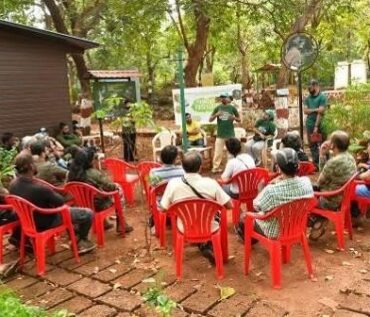
Mr Nikhil Bhopale announcing the
observations of PBC event

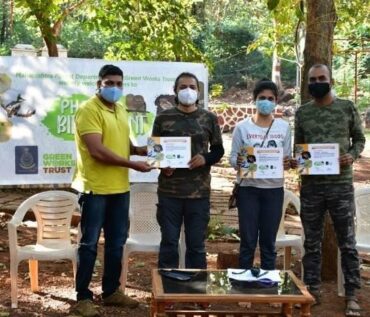
Participants receiving certificates
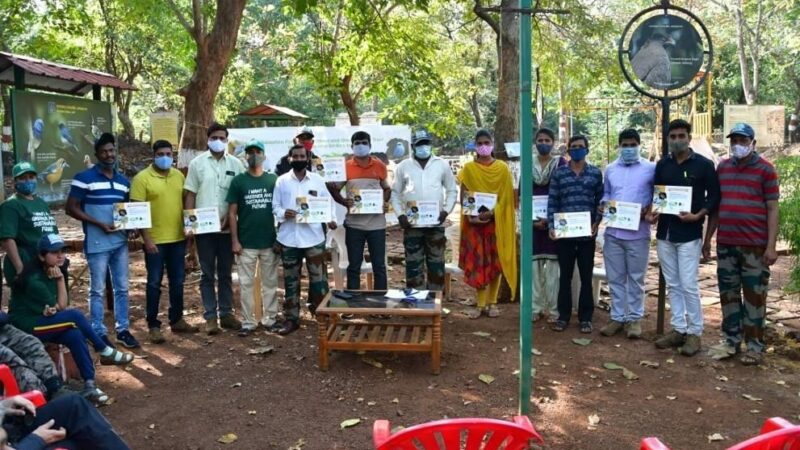
Maharashtra Forest Department officials receiving certificates
The entire event was successfully completed without using any unethical methods. GWT strongly supports the #noplaybackpolicy. All observations were documented without harming or disturbing organisms.
Participants posed for photos with bird count & NPP poster, to show their support towards green cause with ethical practice.
We extend our thanks to Maharashtra Forest Department for their strong and thoughtful support to this initiative.

Maharashtra Forest Department, PBC participants and GWT team
Abhishek Mane, Dipali Bhopale, Gargi Geedh, Gaurav Patil, Kishor Shirkande, Krupa Thakur- Patil, Mihir Sore, Nikhil Bhopale, Pranav Bagwe, Prathamesh Mokal, Sagar Satpute, Saurabh Kulkarni, Sayee Girdhari, Vaibhav Patwardhan.
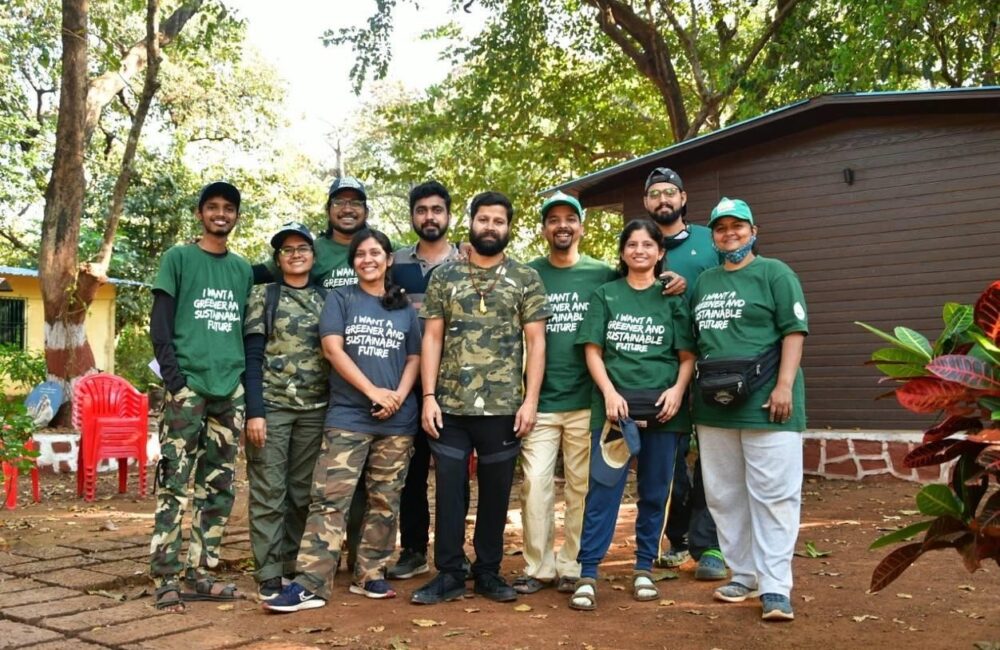
GWT team of PBC January 2022
GWT aims at conducting the Bird Count event in different seasons of the year for at least 5 consecutive years in order to collect data for analysis. We are thankful to the Maharashtra Forest Department for assuring their continued support in this initiative. GWT also aims at conducting similar events for reptiles, amphibians and butterflies etc. at various protected areas. We believe that bringing together citizens and the Forest Department for such activities will help in building substantial data about biodiversity and also spread awareness which eventually will be helpful for conservation activities.
Green Works Trust looks forward to your participation and support in our future initiatives.
To know more about the activities and initiatives of Green Works Trust, Follow us on Instagram and Facebook.

Scan to follow us on Instagram

Scan to follow us on Facebook
References:
Checklist of Avifauna
GREEN WORKS TRUST
A-101 Poonam Jewel,
Poonam Nagar,
Sardar Vallabhbhai Patel Road,
Andheri East, Mumbai 400 093.